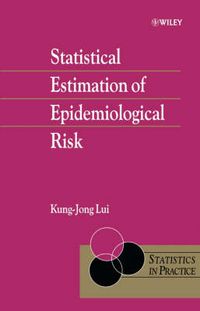
endast ny
Statistical Estimation of Epidemiological Risk Upplaga 1
Statistical estimation of indices for measuring risk is a key topic in epidemiology. A good estimator, that is unbiased and efficient, can help investigators search for the possible causes of disease. Good use of statistical methods can enable public health administrators to confidently allocate their limited resources to the appropriate methods of prevention and treatment. Statistical Estimation of Epidemiological Risk presents the most-commonly used measures of risk, and adopts a practical approach using many real and numerical examples to support the methodology. *Presents a practical overview of the key measures of epidemiological risk. *Features coverage of various sampling methods, and pointers to where each should be used. *Each measure discussed is supported by a number of real and numerical examples that highlight their practical use. *Each chapter is self-contained, allowing the book to be used as a reference source. *Includes an abundance of exercises, which give the reader a clearer understanding of the theory. *Suitable for epidemiologists and public health professionals with a modest statistical background. Statistical Estimation of Epidemiological Risk is both a useful practical reference for researchers from biostatistics and epidemiology, and an accessible textbook for graduate students studying epidemiological risk. The range of examples and exercises are of great practical benefit to public health professionals working in disease prevention and control, and set this book apart from others on the topic.
Upplaga: 1a upplagan
Utgiven: 2004
ISBN: 9780470850718
Förlag: John Wiley & Sons
Format: Inbunden
Språk: Engelska
Sidor: 206 st
Statistical estimation of indices for measuring risk is a key topic in epidemiology. A good estimator, that is unbiased and efficient, can help investigators search for the possible causes of disease. Good use of statistical methods can enable public health administrators to confidently allocate their limited resources to the appropriate methods of prevention and treatment. Statistical Estimation of Epidemiological Risk presents the most-commonly used measures of risk, and adopts a practical approach using many real and numerical examples to support the methodology. *Presents a practical overview of the key measures of epidemiological risk. *Features coverage of various sampling methods, and pointers to where each should be used. *Each measure discussed is supported by a number of real and numerical examples that highlight their practical use. *Each chapter is self-contained, allowing the book to be used as a reference source. *Includes an abundance of exercises, which give the reader a clearer understanding of the theory. *Suitable for epidemiologists and public health professionals with a modest statistical background. Statistical Estimation of Epidemiological Risk is both a useful practical reference for researchers from biostatistics and epidemiology, and an accessible textbook for graduate students studying epidemiological risk. The range of examples and exercises are of great practical benefit to public health professionals working in disease prevention and control, and set this book apart from others on the topic.
Ny bok
1411 kr1485 kr
5% studentrabatt med Studentapan
Begagnad bok (0 st)
Varje vecka tillkommer tusentals nya säljare. Bevaka boken så får du meddelande när den finns tillgänglig igen.



